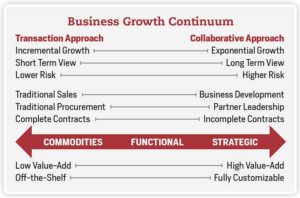The number of partnerships has continued to rise over the past three decades, and the trend doesn’t look like it will end in the near future.
According to PwC’s 2016 Global CEO Survey, 59 percent of U.S. CEOs planned to initiate a new business growth partnership within the next year, an increase of 15 percent over the 2015 survey results.
It’s understandable why partnerships are popular: They can be a powerful, cost-effective strategy for growing a business.
The term partnership is very “wide,” so let me clarify. The broadest classification for business partnerships is an alliance. This includes arrangements such as equity joint ventures, mergers, capital investments, R&D cost sharing, outsourcing, vendor agreements, cooperatives and referral relationships.
Time and Commitment
All partnerships can be characterized by two elements: time and the level of commitment involved.
The first dimension, time, speaks to the speed at which we can generate revenues and enhance our products or services.
For example, a vendor partnership allows your company to purchase goods that you sell this quarter, benefiting you in the short term. The other end of the time spectrum might include a product development partnership that requires years to bring a new product to market—a long-term play.
The second dimension of a partnership, commitment, speaks to the level of obligation that each partner has to the joint initiative.
As an example, equity ownership ventures require a much greater level of commitment than partnerships involving informal sales referrals.
By better understanding the types of business partnerships available, we can begin to build a plan based upon our specific needs.
Transactional vs. Collaborative
Another way to categorize partnerships is transactional versus collaborative.
Consider the Business Growth Continuum in the accompanying chart. The left side focuses on the transactional approach to business growth. These arrangements tend to have a short-term view.
The vendor partnership I described above is a good example of the transactional approach.
Here, in collaboration with your vendor partner, your procurement manager purchases inputs (commodities) that feed your production process. These daily activities allow your sales team to close transactions (or enable field teams to deliver services) that generate revenue. The time horizon of these activities is usually less than one year—relatively short.
The right side of the continuum describes the collaborative approach to partnering. This side offers the risk-taker a shot at exponential business growth.
Here, your business development professional puts his or her entrepreneurial skills to the test by finding a market-leading partner that can deliver unique resources that fuel significant growth. The time horizon for the collaborative side varies, but it is generally one to two years before any meaningful revenues are realized.
Look for Wild Cards
The “wild card” strategy of partnering with another company can be a very effective way to grow your business. A successful partnership can allow your company to mitigate risk, reduce cost, increase speed to market and leverage the expertise of another company.
I use the term “wild card” to describe partnerships because great partners will provide the exact, but often unique, element that you need to grow. As the business leader, your challenge is to find the company that can efficiently provide the resources you need.
If the collaborative approach takes one to two years to generate meaningful revenue, why would a business want to pursue those kinds of projects? We want revenue now—right?
The collaborative approach brings an exceptional opportunity: the ability to combine best-in-class resources from multiple companies
to create a game-changing product, service or process. When this occurs, your strategic partnership is primed to reap the rewards that come from achieving a competitive advantage—exponential revenue growth.
Earlier this year, I had a conversation with Bernie Brenner, co-founder of TrueCar, a website that shares pricing and other information on vehicles. Bernie said that strategic partnerships with large brands such as USAA and American Express allowed their young company to grow at exponential rates. He added that it is not uncommon for small businesses to achieve ten-fold growth if they find the right partner.
As business leaders, we need to remember that both partnership types, transactional and collaborative, are essential ingredients for maximum business growth.
Great partnerships allow both companies to become better as a result of the relationship, regardless of scope. The success of a partnership is limited only by one’s ability to lead.


